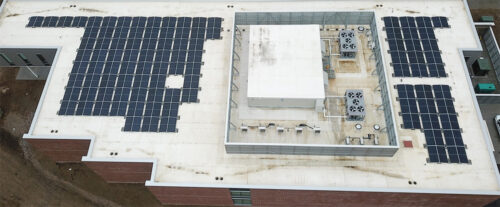The University of Pittsburgh completed the installation of the first of several rooftop solar installations across multiple campuses. The 108-kW system is installed on the George B. Duke Engineering and Information Technologies Building on the Pitt-Bradford campus in Bradford, Pennsylvania. Now operational, it is expected to produce 116,500 kWh of electricity each year.
The rooftop solar installation is a key part of the university’s goal to achieve Leadership in Energy and Environmental Design (LEED) certification for the Pitt-Bradford building, which serves as the campus hub for engineering, computing and energy studies. It will help power the facility’s virtual reality lab, networking lab, maker space, ample fabrication space and engineering shops.
The solar system was designed and installed by Pittsburgh-based installer, EIS Solar. It chose SolarEdge’s DC-optimized inverter solution to overcome design challenges that would have otherwise significantly reduced the amount of energy the system could produce.
“While the new Pitt-Bradford building is remarkable, the solar installation component was technically very challenging,” said Joe Morinville, president, EIS Solar. “The roof accommodates a large mechanical penthouse, which meant we were only able to install panels on about one-third of the roof. Another challenge was the 9-ft-tall skirting around the penthouse which will cast shading over portions of the solar array at certain times of the day. Given these constraints, it would not have been possible to generate enough power from the roof with a traditional string inverter system to make solar a viable investment for the university. However, with SolarEdge’s DC-optimized technology we have been able to realize Pitt’s vision of powering its curriculum with clean, renewable energy.”
The Pitt-Bradford system is composed of 200 bifacial modules which are installed in two separate arrays on either side of the penthouse. Each array is controlled by a SolarEdge inverter and uses SolarEdge Power Optimizers attached to each pair of modules that enables them to operate independently from others on the same string. This provided EIS Solar with the flexibility to position the modules in an east-west configuration and in uneven string lengths – crucial to maximize the number of modules that could fit onto the roof.
The power optimizers bring additional production gains by mitigating power losses caused by module degradation and mismatch. The latter is especially common in bifacial modules due to the reduced surface albedo and irradiance differences on the rear side of the modules caused by their close proximity to the roof.
“We have been operational in Pittsburgh for 14 years and from day one SolarEdge has been our go-to inverter solution,” Morinville said. “For high-energy consumers such as Pitt-Bradford, every watt of power counts.”
The bifacial rooftop array on the University of Pittsburgh’s Pitt-Bradford campus is expected to offset 40% of the building’s total electricity use.
“Pitt-Bradford is proud to boast the largest rooftop array across five University of Pittsburgh campuses to date,” said Matt Kropf, director of the Energy Institute at Pitt-Bradford. “This new solar installation joins one on the Richard E. and Ruth McDowell Sport and Fitness Center in helping Pitt-Bradford students experience the importance of solar first-hand in our growing energy and science curricula and our region.”






